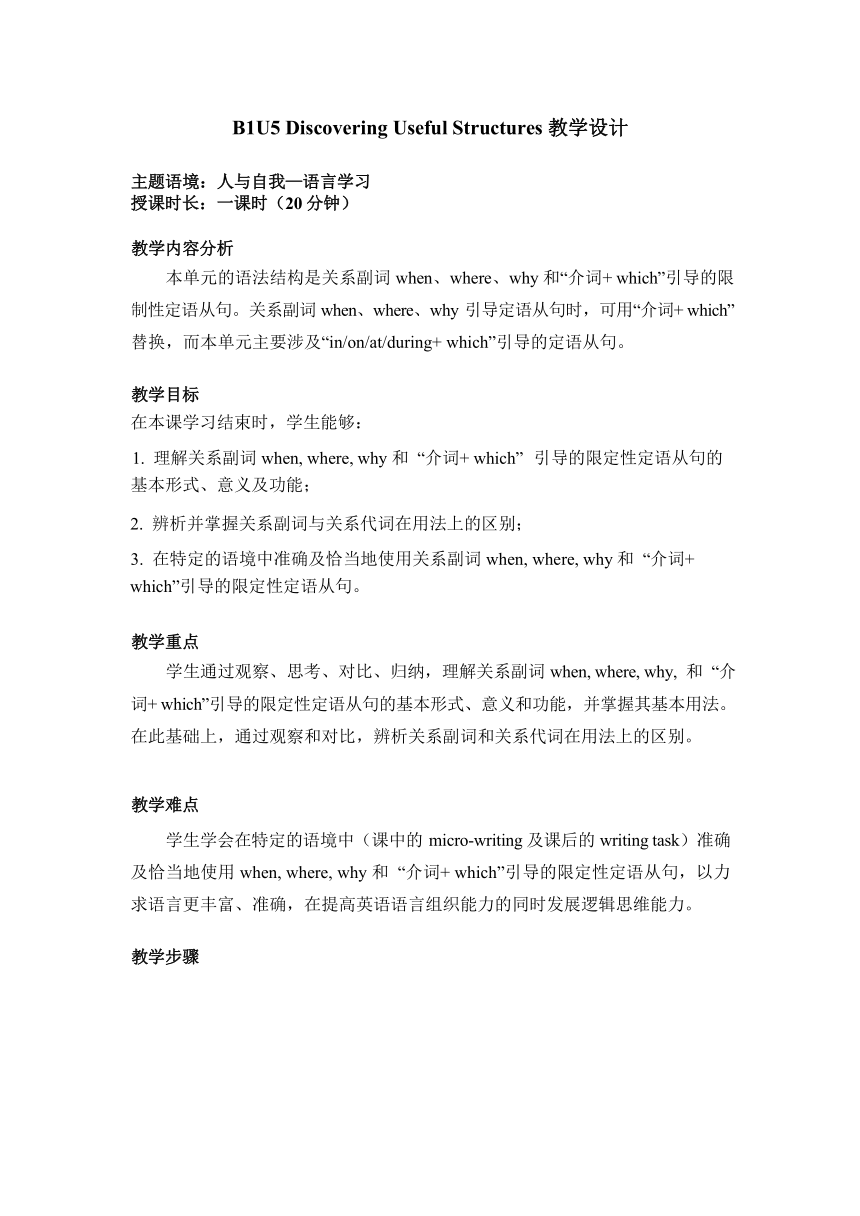人教版(2019)必修 第一册Unit 5 Languages around the world Discovering useful structure Using structures 教案(表格
文档属性
| 名称 | 人教版(2019)必修 第一册Unit 5 Languages around the world Discovering useful structure Using structures 教案(表格 |  | |
| 格式 | docx | ||
| 文件大小 | 22.2KB | ||
| 资源类型 | 教案 | ||
| 版本资源 | 人教版(2019) | ||
| 科目 | 英语 | ||
| 更新时间 | 2025-03-03 10:04:02 | ||
图片预览


文档简介
B1U5 Discovering Useful Structures 教学设计
主题语境:人与自我—语言学习 授课时长:一课时(20 分钟)
教学内容分析
本单元的语法结构是关系副词 when、where、why 和“介词+ which”引导的限 制性定语从句。关系副词 when、where、why 引导定语从句时,可用“介词+ which” 替换,而本单元主要涉及“in/on/at/during+ which”引导的定语从句。
教学目标
在本课学习结束时,学生能够:
1. 理解关系副词 when, where, why 和 “介词+ which” 引导的限定性定语从句的 基本形式、意义及功能;
2. 辨析并掌握关系副词与关系代词在用法上的区别;
3. 在特定的语境中准确及恰当地使用关系副词 when, where, why 和 “介词+ which”引导的限定性定语从句。
教学重点
学生通过观察、思考、对比、归纳,理解关系副词 when, where, why, 和 “介 词+ which”引导的限定性定语从句的基本形式、意义和功能,并掌握其基本用法。 在此基础上,通过观察和对比,辨析关系副词和关系代词在用法上的区别。
教学难点
学生学会在特定的语境中(课中的 micro-writing 及课后的 writing task)准确 及恰当地使用 when, where, why 和 “介词+ which”引导的限定性定语从句,以力 求语言更丰富、准确,在提高英语语言组织能力的同时发展逻辑思维能力。
教学步骤
步骤 教学活动 设计意图 环节用时
1. Explore & Practice
1.1 Basic forms and meanings of RRC
Step 1 Ss observe the four target sentences from the reading passage and figure out the basic forms of restrictive relative clauses starting with relative adverbs. 关注形式: 通过观察目标语 句,找出由关系 副词引导的限定 性定语从句,对 其基本形式和构 成成分形成一个 初步认识,落实 教学目标 1。 2 mins
Step 2 On top of that, Ss proceed to work out the question: “What do ‘when’, ‘where’, ‘why ’ and ‘on which ’ refer to in each sentence ” After that, a tip for the basic usages of relative adverbs is given. 关注意义: 思考关系副词的 具体修饰对象, 理解限定性定语 从句的表意功 能。在此基础上, 归纳关系副词的 基本用法,落实 教学目标 1。 2 mins
Step 3 Ss look at more examples, find out restrictive relative clauses and identify the meanings they communicate in each example. 通过练习,巩固 和内化所学:关 注限定性定语从 句的基本形式和 意义。 2 mins
1.2 Basic functions of RRC
Step 4 Ss observe and compare the four target sentences with their counterparts (in the form of simple sentences) and figure out the question: “Why does the author choose to use restrictive relative clauses instead of simple sentences ” . 关注功能: 通过与简单句对 比,理解目标语 法结构在整合信 息,使语言更丰 富、准确,简洁, 提高英语语言组 织能力等方面的 功能,落实教学 目标 2。 2 mins
Step 5 Ss practise connecting simple sentences by using restrictive relative clauses. 通过练习,巩固 和内化所学, 运 用限定性定语从 句整合信息,使 语言更丰富、准 确,提高英语语 言组织能力,简 洁,为后续的 micro-writing 作 铺垫。 2 mins
1.3 Difference between the usages of relative adverbs and relative pronouns
Step 6 Ss tell the difference between relative pronouns and relative adverbs, which is illustrated by a flow chart. 关注用法区别: 关系副词和和关 系代词在用法上 的区别,落实教 学目标 3。 2 mins
Step 7 Based on Step 6, Ss finish some follow-up exercises. 通过 follow-up 练习,巩固和内 化所学:关系副 词与关系代词的 用法区别, 落实 教学目标 3。 2 mins
2. Apply
Step 8 Micro-writing: Ss read an interview talking about a Chinese student's experiences of learning English and finish task 1 and 2. Task 1: rewrite the underlined parts with restrictive relative clauses. Task 2: complete the missing part by using restrictive relative clauses where necessary. 基于以上所学, 结合特定的语境 (一位准大学生 的高中英语学习 经历的访谈),在 语篇中准确及恰 当地使用目标语 法结构:关系副 词引导的限定性 定语从句,力求 语言更丰富、准 确,在提高英语 语言组织能力的 同时发展逻辑思 维能力,落实教 学目标 4。 6 mins
Assignment: 1. Read a passage talking about another person’s experience of learning German and complete the missing parts with relative adverbs or relative pronouns. 2. Write a paragraph of your experiences of learning English.
主题语境:人与自我—语言学习 授课时长:一课时(20 分钟)
教学内容分析
本单元的语法结构是关系副词 when、where、why 和“介词+ which”引导的限 制性定语从句。关系副词 when、where、why 引导定语从句时,可用“介词+ which” 替换,而本单元主要涉及“in/on/at/during+ which”引导的定语从句。
教学目标
在本课学习结束时,学生能够:
1. 理解关系副词 when, where, why 和 “介词+ which” 引导的限定性定语从句的 基本形式、意义及功能;
2. 辨析并掌握关系副词与关系代词在用法上的区别;
3. 在特定的语境中准确及恰当地使用关系副词 when, where, why 和 “介词+ which”引导的限定性定语从句。
教学重点
学生通过观察、思考、对比、归纳,理解关系副词 when, where, why, 和 “介 词+ which”引导的限定性定语从句的基本形式、意义和功能,并掌握其基本用法。 在此基础上,通过观察和对比,辨析关系副词和关系代词在用法上的区别。
教学难点
学生学会在特定的语境中(课中的 micro-writing 及课后的 writing task)准确 及恰当地使用 when, where, why 和 “介词+ which”引导的限定性定语从句,以力 求语言更丰富、准确,在提高英语语言组织能力的同时发展逻辑思维能力。
教学步骤
步骤 教学活动 设计意图 环节用时
1. Explore & Practice
1.1 Basic forms and meanings of RRC
Step 1 Ss observe the four target sentences from the reading passage and figure out the basic forms of restrictive relative clauses starting with relative adverbs. 关注形式: 通过观察目标语 句,找出由关系 副词引导的限定 性定语从句,对 其基本形式和构 成成分形成一个 初步认识,落实 教学目标 1。 2 mins
Step 2 On top of that, Ss proceed to work out the question: “What do ‘when’, ‘where’, ‘why ’ and ‘on which ’ refer to in each sentence ” After that, a tip for the basic usages of relative adverbs is given. 关注意义: 思考关系副词的 具体修饰对象, 理解限定性定语 从句的表意功 能。在此基础上, 归纳关系副词的 基本用法,落实 教学目标 1。 2 mins
Step 3 Ss look at more examples, find out restrictive relative clauses and identify the meanings they communicate in each example. 通过练习,巩固 和内化所学:关 注限定性定语从 句的基本形式和 意义。 2 mins
1.2 Basic functions of RRC
Step 4 Ss observe and compare the four target sentences with their counterparts (in the form of simple sentences) and figure out the question: “Why does the author choose to use restrictive relative clauses instead of simple sentences ” . 关注功能: 通过与简单句对 比,理解目标语 法结构在整合信 息,使语言更丰 富、准确,简洁, 提高英语语言组 织能力等方面的 功能,落实教学 目标 2。 2 mins
Step 5 Ss practise connecting simple sentences by using restrictive relative clauses. 通过练习,巩固 和内化所学, 运 用限定性定语从 句整合信息,使 语言更丰富、准 确,提高英语语 言组织能力,简 洁,为后续的 micro-writing 作 铺垫。 2 mins
1.3 Difference between the usages of relative adverbs and relative pronouns
Step 6 Ss tell the difference between relative pronouns and relative adverbs, which is illustrated by a flow chart. 关注用法区别: 关系副词和和关 系代词在用法上 的区别,落实教 学目标 3。 2 mins
Step 7 Based on Step 6, Ss finish some follow-up exercises. 通过 follow-up 练习,巩固和内 化所学:关系副 词与关系代词的 用法区别, 落实 教学目标 3。 2 mins
2. Apply
Step 8 Micro-writing: Ss read an interview talking about a Chinese student's experiences of learning English and finish task 1 and 2. Task 1: rewrite the underlined parts with restrictive relative clauses. Task 2: complete the missing part by using restrictive relative clauses where necessary. 基于以上所学, 结合特定的语境 (一位准大学生 的高中英语学习 经历的访谈),在 语篇中准确及恰 当地使用目标语 法结构:关系副 词引导的限定性 定语从句,力求 语言更丰富、准 确,在提高英语 语言组织能力的 同时发展逻辑思 维能力,落实教 学目标 4。 6 mins
Assignment: 1. Read a passage talking about another person’s experience of learning German and complete the missing parts with relative adverbs or relative pronouns. 2. Write a paragraph of your experiences of learning English.
